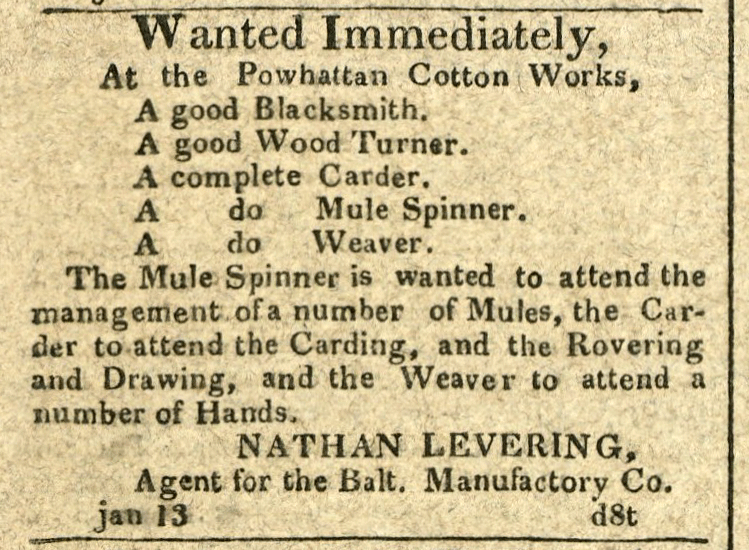
One of the earliest textile factories in Baltimore, the Powhatan Cotton Works was built by the Baltimore Manufacturing Company along the Gwynns Falls, six miles from the city and started production in 1811.
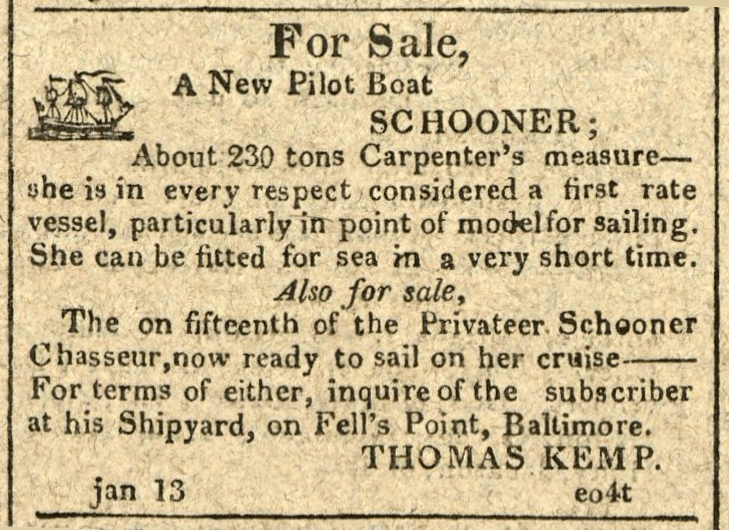
On January 13, 1814, Thomas Kemp advertised the “Privateer Schooner Chasseur” for sale and Captain William Wade prepared to take the ship out on its first cruise. Built by Thomas Kemp for local merchant William Hollins, the Chassuer launched on December 12, 1812 but failed miserably in two attempts to evade the British blockade of the Chesapeake on commercial ventures with the second trip ending in mutiny.
Captain William Wade took command in February 1813 after the ship received a privateer commission and brought recent experience privateering as a second officer on the Comet under Captain Thomas Boyle. The Chasseur weighed almost twice as much as the Comet (resting in Puetro Rico after a damaging fight with the Hibernia just days earlier) and already had a reputation as one of the fastest top sail schooners built to date. Even with Wade’s experience and the ship’s speed, getting past the British might be a difficult task.

On January 12, 1814, a 33-year-old architect named Robert Mills mailed off a “book of designs” to the Board of Managers of the Washington Monument in Baltimore. Accompanying the dozen drawings and pages of notes describing his design, Mills included a letter making the case for his particular qualifications as an American architect:
Gentlemen,
Through your indulgence in granting me a little time beyond the period fixed upon in your advertisement, for designs for the Monument you purpose to erect to commemorate the inestimable virtues and glorious deeds of the immortal Washington, I have now the honor of submitting to your consideration the result of my labors towards accomplishing the Wishes of your honorable board— Accompanying this letter you will find a book of designs with a description of the Monument….
Being an American by birth and having also the honor of being the first American who has passed through a regular course of study of architecture in his own country, it is natural for me to feel much solicitude to aspire to the honor of raising a monument to the memory of our illustrious countryman. The education I have received being altogether American and unmixed with European habits, I can safely present the design submitted as American founded upon those general principles prefaced in the description contained in the Book of Designs. For the honor of our country, my sincere wish is that it may not be said; To foreign genius and to foreign hands we are indebted for a monument to perpetuate the Glory of our beloved Chief.
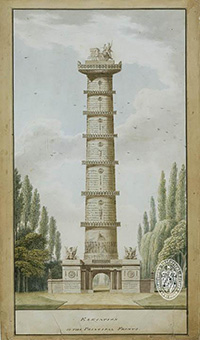
Four years earlier on January 6, 1810, Maryland had authorized the “Board of Managers of the Washington and Monument in Baltimore” to raise funds by lottery to support the design and construction of a monument to George Washington. Delayed by the war and difficulties in raising money, the members of the board voted on February 15, 1813 to hold a design competition with a prize of $500 for the “best design, model or plan for a Monument to the memory of General Washington.”
Robert Mills submitted a detailed description of his proposal back in November along with a few rough sketches. When the board extended competition deadline from January 1 to April 15, it gave him more time to prepare the illustrations contained in his “book of designs,” an essay with a description of the drawings and “a few remarks upon Monuments in general,” and the letter excerpted above.
In claiming the title of America’s first trained architect, Robert Mills played to his strengths despite the debatable nature of his claim. The board’s original announcement for the competition, appearing in the Niles’ Weekly Register on March 20, 1813, remarked:
“it is hoped that the American artist will envince by their productions, that there will be no occasion to resort to any other country for a monument to the memory of their illustrious fellow-citizen.”
Maryland Historical Magazine captured the definitive history of the Washington Monument in an 1939 article where you can find full transcripts of Robert Mills’ proposals and correspondence.
Learn more about the history of the Washington Monument from the Mount Vernon Place Conservancy or on Robert Mills in the excellent history by John M. Bruan: Robert Mills: America’s First Architect.
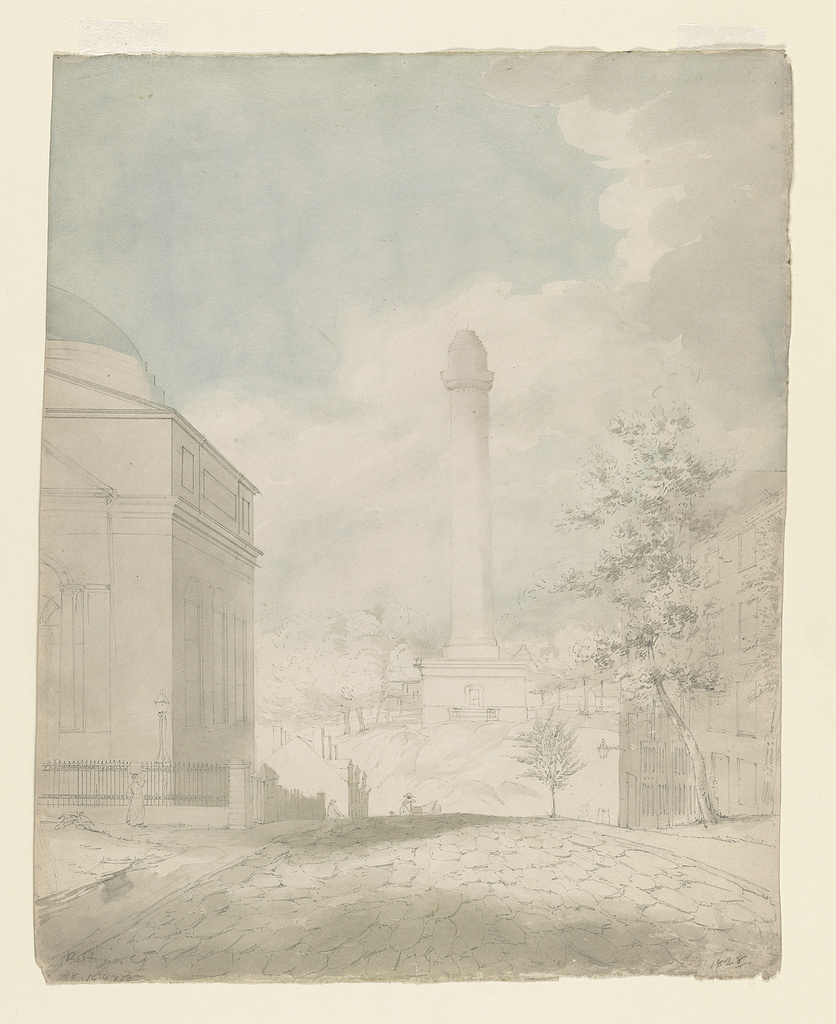
Jan. 12 – Fine clear cool day Wind N.W. – Went to Town return’d to Dinner, sold Chester to Mr. Nicols for $200 –
From the journal of Captain Henry Thompson, January 12, 1814. Courtesy the Friends of Clifton.
11 – Clear & cold, hard Frost last night, Went to Town, din’d at S. Sterrets – A meeting of the Horse Artillery at my Counting House to Elect their Officiers, this evening. Haul’d 9 loads of Ice today, which filled the house, containing 54 loads. Mr. Nicols call’d this evening.
From the journal of Captain Henry Thompson, January 11, 1814. Courtesy the Friends of Clifton.
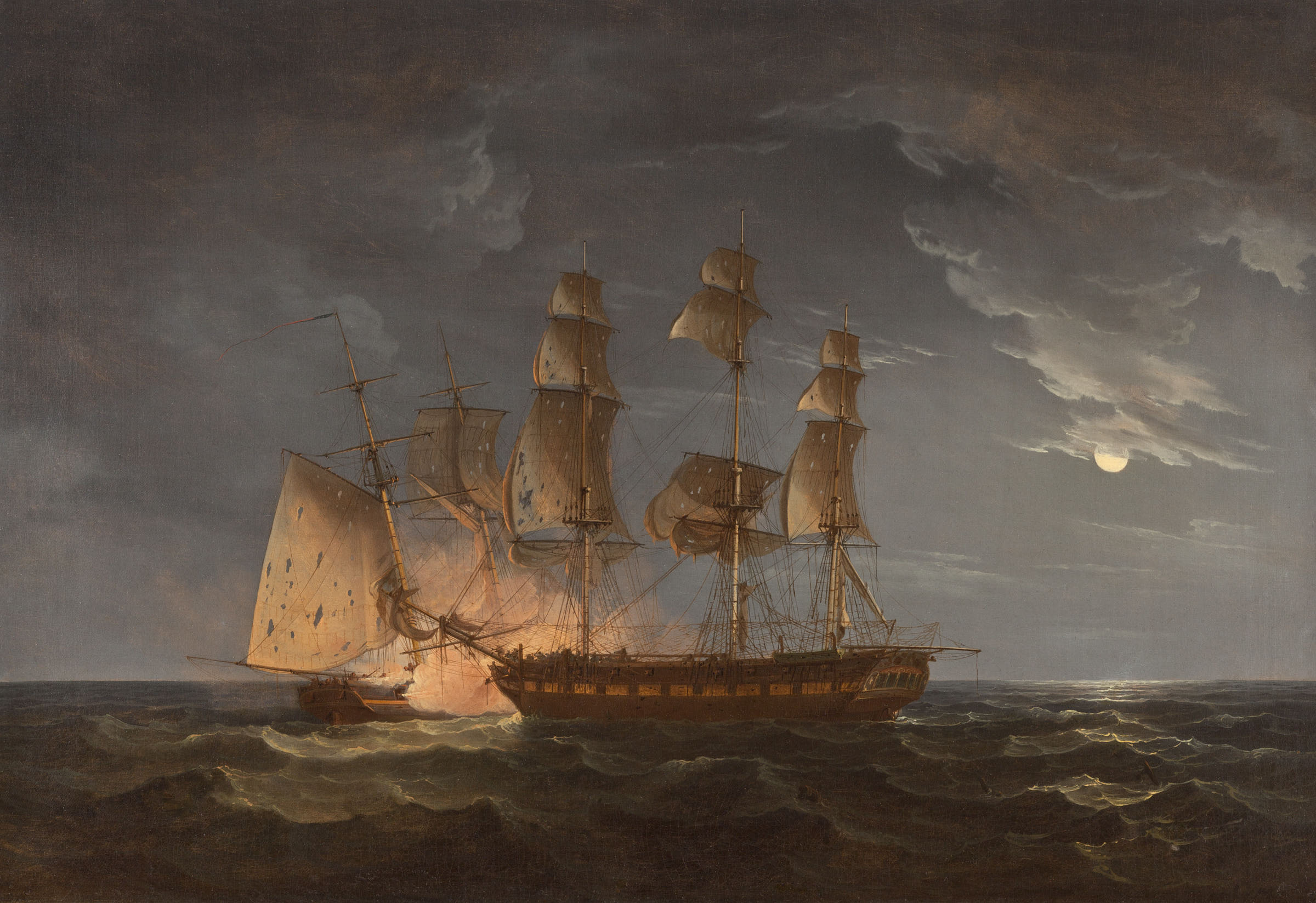
On January 11, 1814 at half-past midnight, the British ship Hibernia fought desperately against an attack by The Comet. Over a year before, in December 1813, the 187-ton Baltimore-built Comet slipped past a British blockade of the Chesapeake Bay and sailed south towards the Caribbean. The ship’s captain, Thomas Boyle, carried a letter of marque from President James Madison—one of five hundred letters Madison issued authorizing private ships to bring the fight to British shipping across the Atlantic.
In a little over a year at sea, Boyle and his crew recorded an astonishing twenty-seven prizes. They were on their way back to Baltimore when the ship spotted and engaged the 800-ton Hibernia in the early afternoon of January 10. After hours of maneuvers and exchanges of cannon fire that continued into the morning hours of January 11, both ships were badly damaged.
Contradictory accounts of the conflict do leave some room for interpretation. British sources, including excerpts from the British ship’s log, suggest the Hibernia was disabled, with only six cannons and a skeleton crew but still managed to kill twenty of Boyle’s crew in a desperate defense. Popular American sources describe the Hibernia differently—a formidable opponent with twenty-two guns and a full crew that left the Comet badly despite Boyle’s brave assault.
The battle ended inconclusively before dawn. The Comet retreated to Puerto Rico for repairs before finally returning home in Baltimore on March 17.
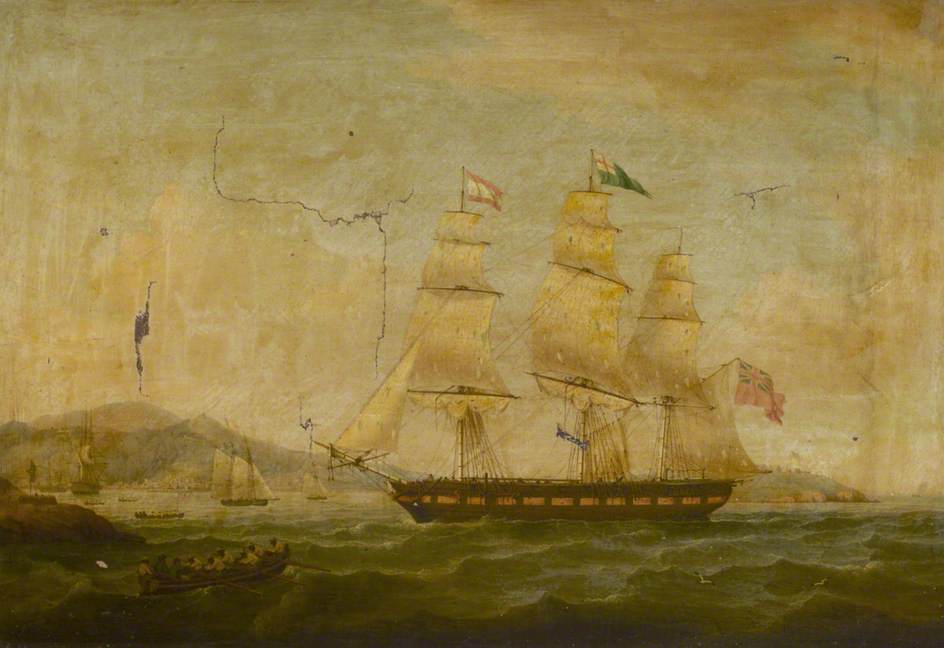
10 Clear’d up. Wind NW but mild – Went to Town din’d at Gadsbys – Snow was about nine inches deep this morning but has diminish’d very much today, being very mild and no Sleighing.
From the journal of Captain Henry Thompson, January 10, 1814. Courtesy the Friends of Clifton.
Baltimore Jany. 9th 1815 [1814]
Sir,In reporting to you the advancement of my ship I have the honor to state, that we got our topmasts on end to day—that our lower rigging is rattled down, and catharping’d in.
The Hold is nearly stowed.— and I intend our yards shall be across next week. I shall stand in need of my sails from Washington.
Had I my compliment of men, I could be ready for sea in three weeks.—
My residing within a hundred yards of my ship since appointed to her, and giving personal attention to every little thing will account to you for my rapid progress.— The “Erie” has more men, but in other respects the “Ontario” is equally advanced. Indeed we have little the start! With great respect your very Obt. ServantR. T. Spence
From a January 9, 1814, letter by Master Commandant Robert T. Spence to Secretary of the Navy William Jones. The Naval War of 1812: A Documentary History, Volume III, p.19
On March 3, 1813, the United States Congress authorized the construction of six sloops-of-war. Naval architect William Doughty designed three of the six ships and directly supervised the construction of the USS Argus at the Washington, DC shipyards. In Baltimore, Thomas Kemp took Doughty’s designs and began work on the remaining two, the USS Ontario and USS Erie, at his Fell’s Point shipyard.
The Erie launched from the shipyard on November 3, 1813 and The Ontario followed on November 28, 1813. Master Commandant Robert T. Spence, commander of the USS Ontario, spent the winter months of 1814 struggling to recruit enough men to set sail—a delay that ultimately kept the Ontario stuck in Baltimore behind the British blockade of the Chesapeake through the end of the war.
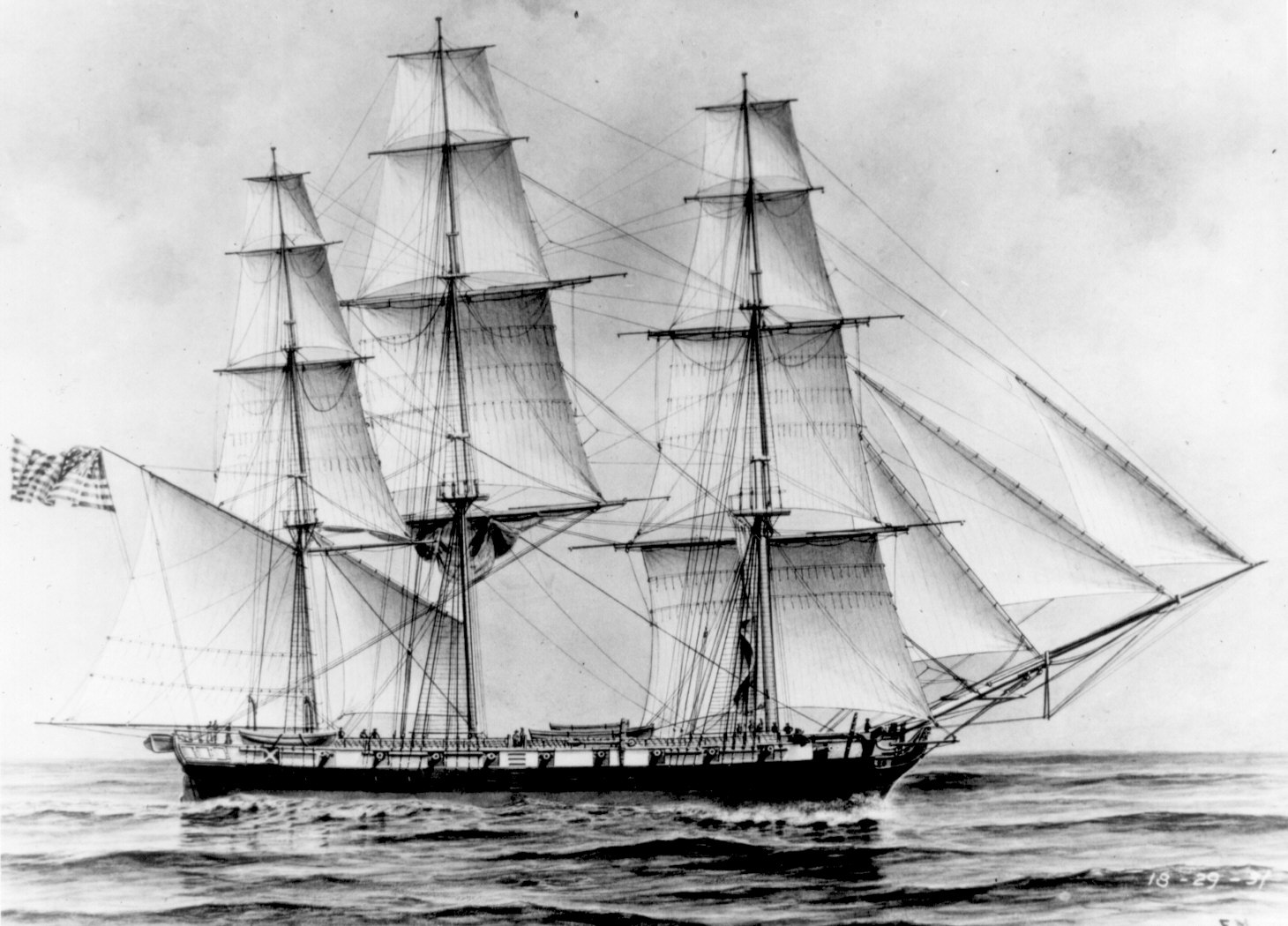
Sunday 9 – Cloudy morning Wind NE – Commenc’d snowing at 12 O’Clock and continued all day & Night, but not cold – Remain’d at home & no visitors –
From the journal of Captain Henry Thompson, January 9, 1814. Courtesy the Friends of Clifton.
Subscribe to receive our weekly updates by email or check out our review of stories from January 1-8, 1814 on the Baltimore Heritage blog.